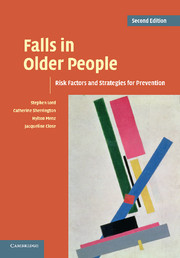Book contents
- Frontmatter
- Contents
- Preface
- Acknowledgements
- Part I Epidemiology and risk factors for falls
- 1 Epidemiology of falls and fall-related injuries
- 2 Postural stability and falls
- 3 Gait characteristics and falls
- 4 Sensory and neuromuscular risk factors for falls
- 5 Psychological factors and falls
- 6 Medical risk factors for falls
- 7 Medications as risk factors for falls
- 8 Environmental risk factors for falls
- 9 The relative importance of falls risk factors: an evidence-based summary
- Part II Strategies for prevention
- Part III Research issues in falls prevention
- Index
- References
8 - Environmental risk factors for falls
Published online by Cambridge University Press: 03 May 2010
- Frontmatter
- Contents
- Preface
- Acknowledgements
- Part I Epidemiology and risk factors for falls
- 1 Epidemiology of falls and fall-related injuries
- 2 Postural stability and falls
- 3 Gait characteristics and falls
- 4 Sensory and neuromuscular risk factors for falls
- 5 Psychological factors and falls
- 6 Medical risk factors for falls
- 7 Medications as risk factors for falls
- 8 Environmental risk factors for falls
- 9 The relative importance of falls risk factors: an evidence-based summary
- Part II Strategies for prevention
- Part III Research issues in falls prevention
- Index
- References
Summary
This chapter assesses the importance of a range of environmental factors that are predisposing to falls. This involves a discussion of aspects of indoor and outdoor environments which have been suggested to contribute to falls, the strength of the evidence for the role of these factors in falling, and the interaction between the environment and the older person's physical capabilities. Chapter 14 in the second part of this book examines the effectiveness of strategies to address potential environmental hazards as a falls prevention strategy.
Suggested environmental risk factors
Numerous environmental factors have been suggested to be associated with falls in older people and these are summarized in Table 8.1. These factors have been identified from reports by older people who have fallen and by structured observation of household environments. In response to these observations and in an attempt to standardize home assessment procedures, a number of home hazard checklists have been developed. These include the Home Environment Survey, the Westmead Home Safety Assessment the Home Assessment Profile, the Safety Assessment of Function and the Environment for Rehabilitation tool (SAFER), the Home Falls and Accidents Screening Tool (HomeFAST) and the Home-Screen tool. The content of these tools varies considerably with respect to the number of items (ranging from 10 to 73), the inclusion of footwear as an environmental risk factor, the inclusion of behavioural factors related to how the older person interacts with their environment and the level of training required to perform the assessment.
- Type
- Chapter
- Information
- Falls in Older PeopleRisk Factors and Strategies for Prevention, pp. 151 - 160Publisher: Cambridge University PressPrint publication year: 2007



